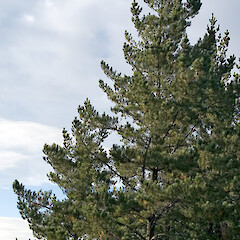Pinus radiata
Common name
Monterey pine, radiata pine
Family
Pinaceae
Flora category
Vascular – Exotic
Structural class
Trees & Shrubs - Gymnosperms
NVS code
The National Vegetation Survey (NVS) Databank is a physical archive and electronic databank containing records of over 94,000 vegetation survey plots - including data from over 19,000 permanent plots. NVS maintains a standard set of species code abbreviations that correspond to standard scientific plant names from the Ngä Tipu o Aotearoa - New Zealand Plants database.
PINRAD
Conservation status
Not applicable
Habitat
Terrestrial. A plant of coastal and lowland habitats (Timmins & MacKenzie 1995). A plant of low fertility sites (Timmins & MacKenzie 1995). The plant occurs in scrub and forest margin, shrubland, short tussockland, sand dunes, cliffs and bluff communities (Timmins & MacKenzie 1995).
Wetland plant indicator status rating
Information derived from the revised national wetland plant list prepared to assist councils in delineating and monitoring wetlands (Clarkson et al., 2021 Manaaki Whenua – Landcare Research Contract Report LC3975 for Hawke’s Bay Regional Council). The national plant list categorises plants by the extent to which they are found in wetlands and not ‘drylands’. The indicator status ratings are OBL (obligate wetland), FACW (facultative wetland), FAC (facultative), FACU (facultative upland), and UPL (obligate upland). If you have suggestions for the Wetland Indicator Status Rating, please contact: [Enable JavaScript to view protected content]
FACU: Facultative Upland
Occasionally is a hydrophyte but usually occurs in uplands (non-wetlands).
Detailed description
Medium to large tree (40–60 m in cultivation). Needles are slender, about 15 cm long, deep or dark green and held in bunches of 3. Male cones are clustered at ends of new shoots in spring, light-brown to pinkish. Female cones are 12 × 8 cm, brown, in clusters of up to 6 and backwards pointing.
Similar taxa
Dark green, relatively short (15 cm) stout (1.2–2 mm thick) needles in clusters of 3, rigid and spreading in different directions. New shoots usually brown. large persistent egg-shaped branch cones without spikes, held in clusters of 1–6.
Flower colours
No flowers
Life cycle
Perennial. Seeds germinate in Spring; wind dispersed (Timmins & MacKenzie 1995). Seed is produced annually and is known to remain viable at 4 years (ibid.).
Year naturalised
1904
Origin
Coastal California, N. America
Reason for introduction
Forestry
Tolerances
The plant is tolerant to drought and intolerant to shade and frost (Timmins & MacKenzie 1995). Physical damage and grazing result in regrowth if green foliage remains intact (Timmins & MacKenzie 1995). Responds readily after fire, if a seed source is adjacent (Timmins & MacKenzie 1995). Requires very low to medium soil fertility (Atkinson 1997).
CONIFER IDENTIFICATION
The National Wilding Conifer Control Programme team at Biosecurity New Zealand, a branch of Ministry for Primary Industries, has produced this wilding conifer quick ID guide.
References and further reading
Atkinson IAE. 1997. Problem weeds on New Zealand islands. Science for Conservation 45. Department of Conservation, Wellington, NZ. 58 p.
Timmins SM, Mackenzie IW. 1995. Weeds in New Zealand Protected Natural Areas database. Department of Conservation Technical Series 8. Department of Conservation, Wellington, NZ. 282 p.












